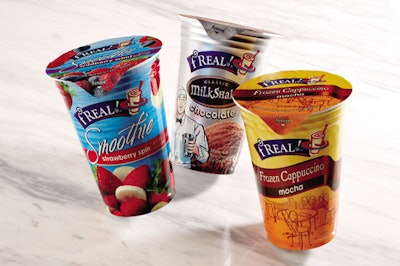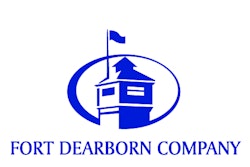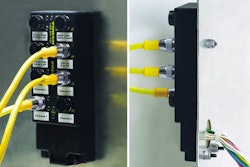When done properly, packaging graphics can perform a distinctive double duty in relieving consumer confusion. Graphics can differentiate products from the competition, and they can also distinguish separate lines within a family of products.
That’s what f’REAL! Foods, Orinda, CA, achieved when it switched from preprinted cups to shrink sleeves for its 10-oz cups of frozen dairy products sold at convenience stores. The 2-mil polyvinyl chloride sleeves, provided by Fort Dearborn, are gravure-printed in nine colors; an adhesive is applied on a 10th station. The sleeves are shrunk around tapered cups, custom-molded of high-impact polystyrene, supplied by Fabri-Kal (www.fabrikal.com). The cups remained unchanged.
There were multiple drivers for the change to sleeves. Says f’REAL director of operations Jens Voges, “We wanted to really differentiate the product lines. We wanted to have much higher-resolution graphics so that we could be more flexible in terms of how the product lines were positioned in the marketplace.
“In addition, in the spring, we released our three-product line of smoothies. We wanted to convey the fact that we had real fruit in a natural product. Printing photographs of real fruit was a huge advantage, something that we couldn’t have done with offset printing.
“Likewise, with the milkshakes, we were looking to position them as old-fashioned, the way real milkshakes are made. We wanted a realistic, silver-metal cup look. Again, that was something that wasn’t possible with offset printing.
“We’ve been pretty successful with these changes.” The format has proven not only successful, but groundbreaking, too, Voges says: “As far as we know, ours is the only full-body, printed shrink sleeve on a frozen product.”
Custom mixer, custom cup
F’REAL’s products are sold in 2,500 convenience stores, primarily in the Midwest, including Quick Trip, and in the Eastern U.S. at c-stores, including WaWa. Each of the three product lines—milkshakes, frozen cappuccino, and smoothies—offer three flavors. F’REAL also offers a limited-edition seasonal item, Eggnog Milkshake. A tactic that reduced and simplified its investment risk was debuting the sleeves on the limited-edition eggnog in late 2006 (see packworld.com/view-24250).
The products are used in conjunction with a proprietary mixer machine at the c-store. A consumer selects the product, peels off the lid, and positions the product in the mixer. A custom-molded swirl design on the cup bottom locks it into place. “Our cup needed to be tightly integrated with the blender,” Voges points out.
The user chooses a button on the mixer to select the thickness—medium, thicker, or thinner—and pushes the start button. The cup is raised up into the machine, the product is mixed, and the cup with the custom-mixed product is lowered when the cycle is completed. The customer then pays the $1.99 price at checkout.
The cups are provided sleeved by Eastgate Graphics (www.egigroup.com), which used to offset-print the cups. In a joint development with f’REAL, Eastgate selected and installed a new PDC Model R300 sleeve labeler from PDC Intl. and two PDC KST 80”-long steam tunnels to handle the new format.
Dry heat and steam were both tested. “Steam provides a cleaner, more consistent shrink for the sleeves,” Voges says. The cups are sleeved upside down at a rate of about 250 cups/min.
What set PDC apart in the first place was that its machine could handle freezer-grade PVC film and that it was a domestic company, according to Voges. “We could work closely with them to customize the equipment slightly to work well with our container, and operate at the rates that we needed,” he says.
The cups’ lidstock, supplied by HS Crocker, was updated with new graphics to match the new sleeve graphics. The 1.5-mil unsupported foil structure, with heat-seal adhesive, stayed the same. The foil is flexo-printed in seven colors on the front and in one color on the back.
The lidstock and the sleeved cups are supplied to two dairies that perform f’REAL’s contract packaging operations. Tests using the sleeved cups were conducted with the CPs’ fillers and other equipment, Voges notes. “The sleeves make the cups more rigid and therefore easier to handle throughout production,” he says.
The sleeves also enabled f’REAL to better manage the graphics presentation.
Resolution restrictions
Previously the cups had been offset-printed in a lower-resolution format using line art, which Voges says presented printing challenges on its tapered cups.
“That meant no pictures, and the text was limited as well,” he says. “Printing on a tapered surface is challenging—you can’t achieve a consistent resolution throughout the cup’s entire wall section. For instance, there was good copy in the middle, but the top and the bottom sections became blurrier further from the middle of the cup. That was particularly a problem where the readability of the bar code was concerned; because of layout restrictions on the artwork, the bar code had to be towards the bottom of the cup.”
The offset-printed graphics not only confused bar-code readers, they also confused consumers.
“Resolution limitations with offset printing didn’t allow us to really differentiate between our product lines, which at the time were milkshakes and frozen cappuccinos,” Voges says. “We had a sense that consumers were confused between the two lines. They looked similar enough that when customers looked and picked a frozen cappuccino, they were expecting to get some sort of coffee-flavored milkshake instead of a frozen cappuccino. We were limited in terms of good graphics that could really distinguish the different product lines.”
On the other hand, the use of sleeves on f’REAL’s tapered cups complicated package development.
Frozen and tapered
One major challenge was finding an adhesive and a pattern that worked well on a tapered cup in the -20º F environment of an ice cream freezer, according to Voges. F’REAL went through several iterations just in terms of the adhesive pattern, he adds.
“We started with a conventional checkerboard pattern, but that caused a suboptimal look because you could see the checker pattern through the sleeve enough that it impacted the graphics,” Voges explains. “We had to go through a couple of iterations of different patterns that would hide the adhesive and not appear behind certain [key] design elements on our package.”
The adhesive is applied by a 10th print station during converting. To minimize costs, the company wanted one adhesive cylinder used for all three product lines, each with a different graphic layout.
“The goal was to find an adhesive pattern that was hidden behind the graphics on all of our different product lines,” explains Voges. “We went through different iterations to get a pattern that both worked at the production rates, as well as in the freezer environment, while hiding behind the graphic layouts on all our cups.” The result was a pattern applied at the base, middle, and top portions of the sleeve.
The adhesive itself also presented technical challenges. “It had to have quick-acting tack, but it also had to create a strong, long-term bond that could handle the really cold temperatures,” notes Voges.
F’REAL’s determination through print, adhesive, and other challenges has paid off, and retailers and consumers have warmed to the frozen products’ new format. “This more distinctive, premium-looking packaging made a difference to our consumers and to product sales,” says Voges. “This packaging is definitely more expensive than before, but we’ve been able to justify the cost through more sales.”






























